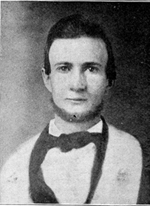
The Knights of the Golden Circle (KGC) was a secret military organization created in 1859 by George W. L. Bickley in Cincinnati, Ohio. Its stated aim was to sponsor and conduct military expeditions into the Caribbean region (the "Golden Circle") for the purpose of bringing new slave territories into the Union. Jingoistic newspapers that supported American intervention in Mexico and similar initiatives included the Norfolk Day Book, which enjoyed some popularity in northeastern North Carolina, especially among subscribers to the Murfreesboro Citizen. Maine native Charles Henry Foster, editor of the Citizen during 1859 and most of 1860, had been associated with the Day Book for a year or two before taking over the Citizen. Through him, the KGC was introduced in North Carolina. On a visit to Norfolk in early 1860, Foster was initiated into the KGC by Virginius D. Groner, a Norfolk militia colonel and ardent supporter of the KGC. (Groner later delivered the order to fire the first gun at Fort Sumter at the start of the Civil War in April 1861.)
Foster returned to Murfreesboro and began promoting the KGC through his newspaper and organizing KGC "castles" at Murfreesboro and nearby communities. Bickley held a KGC convention at Raleigh in May and addressed an audience at Murfreesboro in July. A Citizen editorial warned that acquisition by the federal government of Cuba, Nicaragua, or parts of Mexico by force, purchase, or other means would be accompanied by abolitionist colonization that would exclude slavery from such territories, as in the case of Kansas. The South, therefore, should support only territorial acquisitions that occurred outside federal authority. Like Texas, only these could be reliably settled as slave regions and presented as such for annexation.
During much of 1860, newspapers devoted considerable attention to KGC preparations in Texas for an invasion of Mexico. Some KGC members and groups traveled to Mexico that summer, but it soon became evident that Bickley's claims were much overstated. The confidence of his followers had been seriously eroded before Abraham Lincoln's election as president in November 1860 diverted the nation's attention to the secession crisis. During the Civil War, Gatling gun inventor Richard J. Gatling, a native of Murfreesboro, was suspected of participation in the KGC, but the allegation appears to have been unfounded.